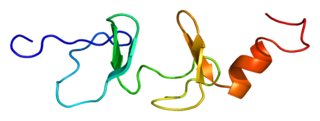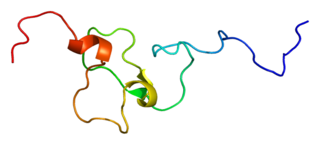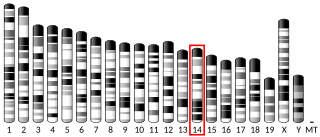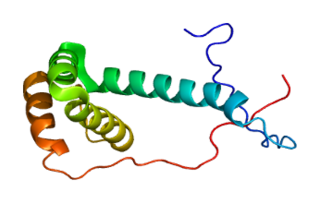
Four and a half LIM domains protein 2 also known as FHL-2 is a protein that in humans is encoded by the FHL2 gene. LIM proteins contain a highly conserved double zinc finger motif called the LIM domain.

Krüppel-like factor 4 is a member of the KLF family of zinc finger transcription factors, which belongs to the relatively large family of SP1-like transcription factors. KLF4 is involved in the regulation of proliferation, differentiation, apoptosis and somatic cell reprogramming. Evidence also suggests that KLF4 is a tumor suppressor in certain cancers, including colorectal cancer. It has three C2H2-zinc fingers at its carboxyl terminus that are closely related to another KLF, KLF2. It has two nuclear localization sequences that signals it to localize to the nucleus. In embryonic stem cells (ESCs), KLF4 has been demonstrated to be a good indicator of stem-like capacity. It is suggested that the same is true in mesenchymal stem cells (MSCs).

LIGHT, also known as tumor necrosis factor superfamily member 14 (TNFSF14), is a secreted protein of the TNF superfamily. It is recognized by herpesvirus entry mediator (HVEM), as well as decoy receptor 3.

RAD52 homolog , also known as RAD52, is a protein which in humans is encoded by the RAD52 gene.

Mortality factor 4-like protein 1 is a protein that in humans is encoded by the MORF4L1 gene.

Dachshund homolog 1, also known as DACH1, is a protein which in humans is encoded by the DACH1 gene. DACH1 has been shown to interact with Ubc9, Smad4, and NCoR.

Vascular endothelial growth inhibitor (VEGI), also known as TNF-like ligand 1A (TL1A) and TNF superfamily member 15 (TNFSF15), is protein that in humans is encoded by the TNFSF15 gene. VEGI is an anti-angiogenic protein. It belongs to tumor necrosis factor (ligand) superfamily, where it is member 15. It is the sole known ligand for death receptor 3, and it can also be recognized by decoy receptor 3.

Inhibitor of growth protein 4 is a protein that in humans is encoded by the ING4 gene.

Small subunit processome component 20 homolog is a protein that in humans is encoded by the UTP20 gene.

PIN2/TERF1-interacting telomerase inhibitor 1, also known as PINX1, is a human gene. PINX1 is also known as PIN2 interacting protein 1. PINX1 is a telomerase inhibitor and a possible tumor suppressor.

Programmed cell death protein 5 is a protein, originally identified as an apoptosis-accelerating protein, that in humans is encoded by the PDCD5 gene.

Zinc finger and BTB domain-containing protein 32 is a protein that in humans is encoded by the 1960 bp ZBTB32 gene. The 52 kDa protein is a transcriptional repressor and the gene is expressed in T and B cells upon activation, but also significantly in testis cells. It is a member of the Poxviruses and Zinc-finger (POZ) and Krüppel (POK) family of proteins, and was identified in multiple screens involving either immune cell tumorigenesis or immune cell development.

Serine/threonine-protein kinase PAK 6 is an enzyme that in humans is encoded by the PAK6 gene.

Synapse-associated protein 1 is a protein that in humans is encoded by the SYAP1 gene.

Protein SDA1 homolog is a protein that in humans is encoded by the SDAD1 gene.

Solute carrier family 52, member 3, formerly known as chromosome 20 open reading frame 54 and riboflavin transporter 2, is a protein that in humans is encoded by the SLC52A3 gene.
In molecular biology mir-365 microRNA is a short RNA molecule. MicroRNAs function to regulate the expression levels of other genes by several mechanisms.
SHC014-CoV is a SARS-like coronavirus (SL-COV) which infects horseshoe bats. It was discovered in Kunming in Yunnan Province, China. It was discovered along with SL-CoV Rs3367, which was the first bat SARS-like coronavirus shown to directly infect a human cell line. The line of Rs3367 that infected human cells was named Bat SARS-like coronavirus WIV1.
Zhimin (James) Lu is a Chinese-American biologist and oncologist. He is a professor, Kuancheng Wang Distinguished Chair, and Dean of Institute of Translational Medicine at Zhejiang University. Prior to joining Zhejiang University in 2019, he was the Ruby E. Rutherford Distinguished Professor and the director of Cancer Metabolism Program at the University of Texas MD Anderson Cancer Center.
LYRa11 is a SARS-like coronavirus (SL-COV) which was identified in 2011 in samples of intermediate horseshoe bats in Baoshan, Yunnan, China. The genome of this virus strain is 29805nt long, and the similarity to the whole genome sequence of SARS-CoV that caused the SARS outbreak is 91%. It was published in 2014. Like SARS-CoV and SARS-CoV-2, LYRa11 virus uses ACE2 as a receptor for infecting cells.




















